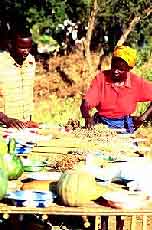
Agricultural Biodiversity
Agricultural biodiversity of all food species is a vital sub-set of general biodiversity, highly threatened by globalisation of food markets and tastes, intellectual property systems and the spread of unsustainable industrial food production, but it provides the basis of the food security and livelihood security of billions of people and the development of all food production, including for industrial agriculture and for the biotechnology (Life) industries. It is the first link in the food chain, developed and safeguarded by farmers, herders and fishers throughout the world.
What is agricultural biodiversity?
Although the term "agricultural biodiversity" is relatively new - it has come into wide use in recent years as evidenced by bibliographic references - the concept itself is quite old. It is the result of the careful selection and inventive developments of farmers, herders and fishers over millennia. Agricultural biodiversity is a vital sub-set of biodiversity. It is a creation of humankind whose food and livelihood security depend on the sustained management of those diverse biological resources that are important for food and agriculture. Agricultural biodiversity, also known as agrobiodiversity or the genetic resources for food and agriculture, includes:
- Harvested crop varieties, livestock breeds, fish species and non- domesticated ('wild') resources within field, forest, rangeland and in aquatic ecosystems;
- Non-harvested species within production ecosystems that support food provision, including soil micro-biota, pollinators and so on; and
- Non-harvested species in the wider environment that support food production ecosystems (agricultural, pastoral, forest and aquatic ecosystems).
Agricultural biodiversity results from the interaction between the environment, genetic resources and the management systems and practices used by culturally diverse peoples resulting in the different ways land and water resources are used for production. It thus encompasses the variety and variability of animals, plants and micro-organisms which are necessary to sustain key functions of the agro-ecosystem, its structure and processes for, and in support of, food production and food security (FAO, 1999).
Agricultural biodiversity has spatial, temporal and scale dimensions especially at agro-ecosystem levels. These agro-ecosystems - ecosystems that are used for agriculture - are determined by three sets of factors: the genetic resources, the physical environment and the human management practices. There are virtually no ecosystems in the world that are "natural" in the sense of having escaped human influence. Most ecosystems have been to some extent modified or cultivated by human activity for the production of food and income and for livelihood security.
Agro-ecosystems may be identified at different levels or scales, for instance, a field/crop/ herd/pond, a farming system, a land-use system or a watershed. These can be aggregated to form a hierarchy of agro-ecosystems. Ecological processes can also be identified at different levels and scales. Valuable ecological processes that result from the interactions between species and between species and the environment include, inter alia, biochemical recycling, the maintenance of soil fertility and water quality and climate regulation (e.g. micro-climates caused by different types and density of vegetation). Moreover, the interaction between the environment, genetic resources and management practices determines the evolutionary process, which may involve, for instance, introgression from wild relatives, hybridization between cultivars, mutations, and natural and human selections. These result in genetic material (farmers' crop varieties or animal breeds) that is well adapted to local abiotic and biotic environmental variation.
So, agricultural biodiversity is not only the result of human activity but human life is dependent on it not just for the immediate provision of food and other goods, but for the maintenance of areas of land that will sustain production and for the maintenance of the wider environment.
Agro-ecosystems comprise polycultures, monocultures, and mixed systems, including crop-livestock systems (rice - fish), agroforestry, agro-silvo-pastoral systems, aquaculture as well as rangelands, pastures and fallow lands. Their interactions with human activities, including socio-economic activity and sociocultural socio-cultural diversity, are determinant. Some of the key functions for maintaining stable, robust, productive and sustainable agro-ecosystems may include the following:
- breakdown of organic matter and recycling of nutrients to maintain soil fertility and sustain plant and consequently animal growth;
- breakdown of pollutants and maintenance of a clean and healthy atmosphere;
- moderation of climatic effects such as maintaining rainfall patterns and modulation of the water cycle and the absorption of solar energy by the land and its subsequent release;
- maintenance and stability of productive vegetative, fish and animal populations and the limitation of invasion by harmful or less useful species;
- protection and conservation of soil and water resources, for example through a vegetative cover and appropriate management practices, and the consequent maintenance of the integrity of landscapes and habitats;
- sequestration of CO2 by plants.
(FAO, 1999)

Farmer exhibiting seeds to her neighbour at the 1998 Maragwa Seed Show, Kenya (PMM/ITDG)
What is COP V?
Agricultural biodiversity
CBD vs WTO
News from COP V
ITDG's position
Sustainable livelihoods workshop
ITDG Home Page
© Copyright ITDG 2000